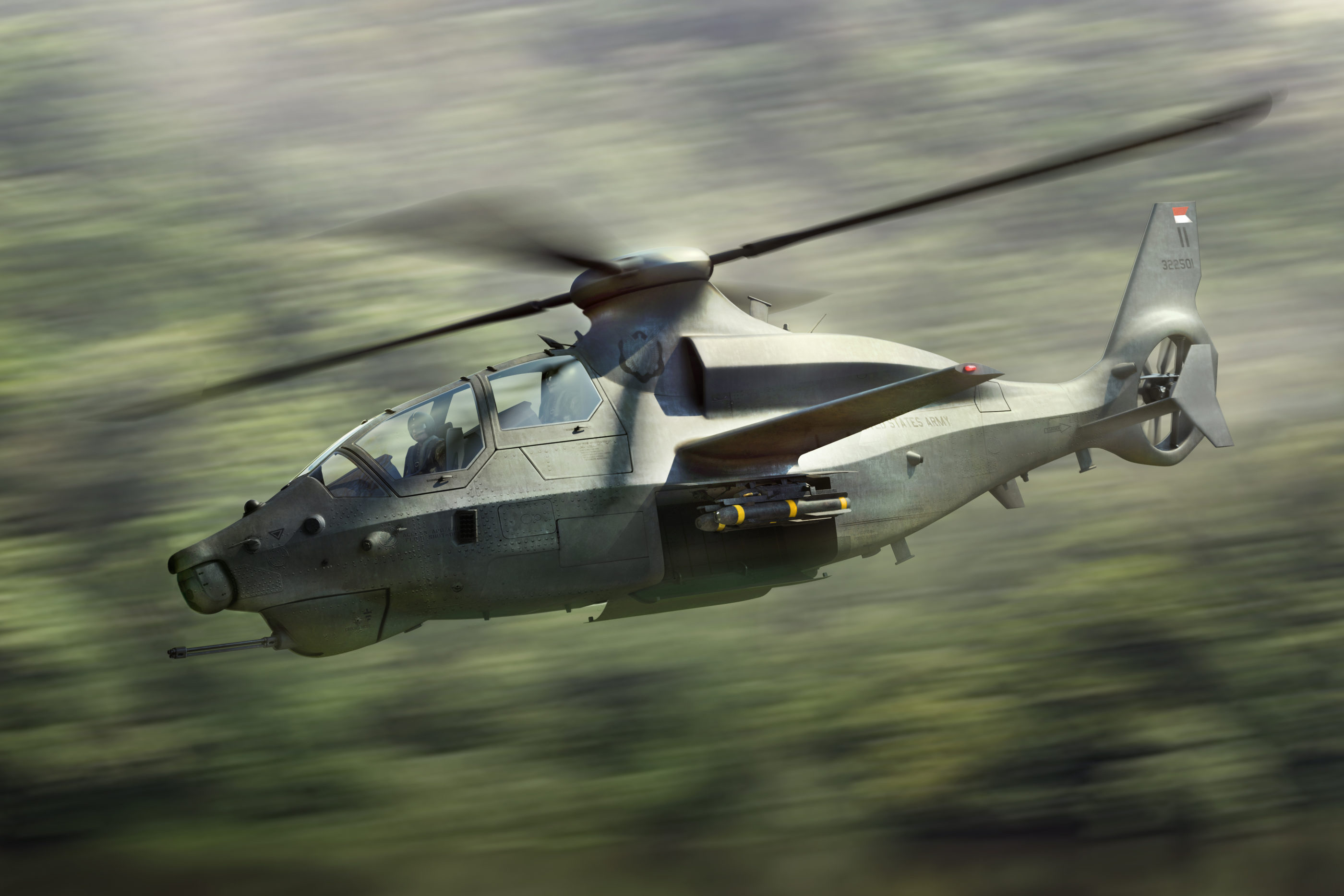Bell plans to use a commercial helicopter engine as the auxiliary power unit for the 360 Invictus, providing a range of benefits for its submission for the U.S. Army’s Future Attack Reconnaissance Aircraft (FARA).

The aircraft, unveiled Oct. 1 at the company’s Advanced Vertical Lift Center outside Washington, D.C., will be powered by a single GE T901 turboshaft, but a Pratt & Whitney Canada PW207D1 — as used in the Bell 429 — will serve as its auxiliary power unit, while also providing supplemental power to the aircraft.
“Advanced aircraft generally all need an auxiliary power unit,” Frank Lazzara, director of advanced vertical lift systems, told reporters during a recent media day at Bell’s headquarters in Fort Worth, Texas. “Our brilliant engineers figured out a way to get the auxiliary power unit capability to buy its way onto the aircraft, [and] they did it through a supplemental power unit [SPU].”
A patent-pending clutch mechanism will allow the SPU to provide additional horsepower to the main transmission, enhancing its capabilities in certain situations. It could also serve to offload accessories that would otherwise add drag to the transmission, said Lazzara.
Bell is one of five companies competing for FARA, alongside AVX Aircraft, Boeing, Karem Aircraft, and Sikorsky.
The OEM has over 200 staff working on the Invictus program, as it seeks to meet the Army’s “very aggressive” timeline, said Lazzara. Nine months of design work will have gone into the aircraft by the time of contract award in March 2020, when the five competitors will be downselected to two, who will each build a competitive prototype.
The desire to meet the Army’s exacting cost and time requirements drove the choice to go for a more conventional design for the aircraft, said Lazzara.
“We looked at all the possible configurations for making vertical lift aircraft go faster, and we wanted to focus in on a technology or a harmonization of technologies that we could produce inside their cost objectives and on that timeline, giving the Army an insurance policy by providing a lower risk path to the capabilities,” he said. “It’s still a very advanced aircraft, but by using technologies that we already had high technology readiness levels in, or manufacturing readiness levels in, we are ahead on that timeline piece.”

The aircraft is designed for speed, with the Army calling for a cruise speed of 180 knots, and a maximum of 205 knots. With this in mind, every element of the Invictus has been chosen to reduce drag as much as possible, including its tandem cockpit. This, combined with its high-speed rotor, with a design borrowed from the upcoming 525 Relentless super medium civil helicopter (which has gone above 200 knots in flight tests), has Bell confident it can meet the Army’s requirements.
Lazzara noted that the increased shrouding over the blades on the Invictus, while designed to reduce drag, also served to allow for a simplified blade design, as less twist was needed on the blades.
“They’re actually very manufacturable,” said Lazzara. “You see what else is out there, what the offerings are for blades. [These are] highly producible, designed for speed, tested, [and] proven. Blades and drags are always big cost and reliability drivers in rotary fleets. That’s going to be a big story for us.”
The aircraft also has a lift-sharing wing that juts out midway up the airframe underneath the main rotor. At 180 knots, the wing assumes 50 percent of the lifting load, said Lazzara. “In rotary-wing aircraft, that main rotor normally provides both lift and thrust,” he said. “If you relieve it of 50 percent of the lifting responsibility for high-speed flight, it can now use that [power] for thrusting capabilities. And . . . it becomes a very efficient propulsion.”
At the rear of the aircraft, its tail rotor is ducted and canted, with the ducting decision again driven by the desire to reduce the aircraft’s drag as much as possible. The canting of the tail rotor generates extra lift in a hover.
In front of the tail rotor is an active horizontal stabilizer. “Flight control computers will be constantly adjusting that to maintain the optimum drag attitude on the aircraft as it pushes through the air,” said Lazzara.
The Invictus will be Bell’s fifth fly-by-wire aircraft, utilizing an advanced digital control system. Lazzara said the aircraft benefits from Bell’s experience with the technology in aircraft including the V-280 Valor and 525.
The Invictus is being designed with an open architecture for its mission systems, and Lazzara said that as a fly-by-wire aircraft, it is on the path to autonomous capability.
“You could see one day where there’s a single pilot in this aircraft . . . doing mission functionality only, [and] somebody in a ground control station is flying the aircraft.”

While Lazzara said he couldn’t discuss what his team’s top speed goal is, he said the Invictus will exceed the Army’s requirements. He added that various changes to the wing design, improved engine performance, or reduced drag were all elements that provide room for speed increases in the future.
Other Army requirements include a range of 135 nautical miles, 90-minute loiter, and 4,000 feet/95 F hover out of ground effect (HOGE) performance.
After contract award next March, the two remaining teams will be working towards a first flight of the competitive prototypes in September 2022, with test and evaluation the following year. The winning aircraft will be chosen by the end of 2023, and the Army hopes to have the first aircraft with a unit in 2028.
The winning aircraft eventually will fill the armed scout role left vacant by the retired OH-58D Kiowa Warrior, now being performed by AH-64E Apaches teamed with RQ-7 Shadow drones.









